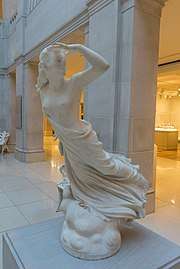Merope (Pleiad)
In Greek mythology, Merope /ˈmɛrəpiː/[1] (Greek: Μερόπη) is one of the seven Pleiades, daughters of Atlas and Pleione. Pleione, their mother, is the daughter of Oceanus and Tethys and is the protector of sailors.[2] Their transformation into the star cluster known as the Pleiades is the subject of various myths.
_-_Lost_Pleiad_(1884).jpg)
Among the Pleiades
In one story, the Pleiades, along with their half sisters the Hyades, were virgin companions to Artemis [3]. Artemis was the twin of Apollo and daughter of Leto and Zeus, and a protector of both hunters and wild animals. The Pleiades were nymphs, and along with their half sisters, were called Atlantides, Modonodes, or Nysiades and were the caretakers of the infant Bacchus.[4]
Orion pursued the Pleiades named Maia, Electra, Taygete, Celaeno, Alcyone, Sterope, and Merope after he fell in love with their beauty and grace. Artemis asked Zeus to protect the Pleiades and in turn, Zeus turned them into stars. Artemis was angry because she no longer could see her companions and had her brother, Apollo, send a giant scorpion to chase and kill Orion. Zeus then turned Orion into a constellation to further pursue the Pleiades in the skies.[5]
In another legend, the sisters were transformed by Zeus into stars because Orion fell in love with them and relentlessly pursued their affection for 12 years. At first they were turned into doves, but later, along with Orion, into stars so that forever the hunter Orion would pursue them.[2]
In either legend the Pleiades were turned into stars and now, along with their half sisters, the Hyades (who died weeping for their dead brother Hyas), are part of the star constellation Taurus.
Marriage
Merope is the faintest of the stars because she was the only of the Pleiades to have married a mortal. Her sisters had relations with gods and bore them sons, but Merope married Sisyphus and lived on the island Chios. Merope gave birth to Glaukos, Ornytion, Almus, Thersander and Sinon. The star Merope is often called the "lost Pleiad" because she was at first not seen by astronomers or charted like her sisters. One myth[6] says that she hid her face in shame because she had an affair with a mortal man, another says she went to Hades with her husband, Sisyphus.[7]
In art

L'etoile Perdue (The Lost Star, 1884) by William Adolphe Bouguereau depicts Merope with her sister Pleiades in the background.
The Lost Pleiade (marble sculpture, 1874/75) by Randolph Rogers depicts Merope, as inspired by the Roman author Ovid's poem Fasti which recounts the legend of the seven sister stars. It is on display in the Art Institute of Chicago.
In popular culture
Merope is the name of the absent mother of the young protagonist in The Game by Diana Wynne Jones.
Merope is the real name of the time traveler "Eileen O'Reilly" in the novel Blackout/All Clear by Connie Willis. It is appropriate because she marries a "contemporary" of the era to which she time-travels.
Merope Gaunt is the name of Voldemort's mother in the Harry Potter series. She marries a Muggle against the wishes of her family, and produces one son, Tom Riddle, who would grow up to be Lord Voldemort.
The star Merope (and the Pleiades cluster) is involved in an ongoing alien mystery within the game Elite Dangerous; specifically the planet Merope 5c has been strangely targeted by alien Unknown Artifacts.
Merope is the sun of the planet Darqueworld in the novel Monster Stalker: A Darquepunk Novel by Elizabeth Watasin.
References
- Noah Webster (1884) A Practical Dictionary of the English Language
- The Pleiades in mythology, Pleiade.org
- Scholiast to Iliad, 18.486. https://scaife.perseus.org/reader/urn:cts:greekLit:tlg5026.tlg001.1st1K-grc1:2.18.198/ This in turn cites the lost Epic Cycle
- Mythology of the Seven Sisters (Pleiads), National Astronomy and Ionosphere Center (Arecibo Observatory)
- Pleiades, in Greek mythology, InfoPlease
- Ovid, Fasti 4.169–178; Robert A. Kaster, Emotion, Restraint, and Community in Ancient Rome (Oxford University Press, 2005), p. 79.
- Merope: Definition, Answers.com

Bibliography
- Gibson, Steven. "Merope". Pleiades Mythology. Retrieved 22 April 2009.
- "Merope". Answers.com. 2009. Retrieved 22 April 2009.
- "Pleiades". The Columbia Electronic Encyclopedia. Infoplease. 2007. Retrieved 22 April 2009.
Further reading
- Calame, Claude. Myth and History in Ancient Greece. 1996. Trans. Daniel W. Berman. New Jersey: Princeton University, 2003.
- Ceci, Lynn. "Watchers of the Pleiades: Ethnoastronomy among Native Cultivators in Northeastern North America." Ethnohistory 25.4 (1978): 301-317.
- Gould, John. "Law, Custom, and Myth: Aspects of the Social Position of Women in Classical Athens." Myth, Ritual, Memory, and Exchange Essays in Greek Literature and Culture. New York: Oxford University, 2001. 112-157.
- Interpretations of Greek Mythology. 1987. Comp. Jan Bremmer. London: Routedge, 1990.
- Kellett, E. E. The Story of Myths. New York: Harcourt, Brace, and Company, 1927.
- Kershaw, Stephen P. The Greek Myths Gods, Monsters, Heroes, and the Origins of Storytelling. Brief Guide. New York: Carroll and Graf, 2007.
- Larson, Jennifer. Greek Nymphs: Myth, Cult, Lore. New York: Oxford University, 2001.
- Women’s Roles in Ancient Civilizations. Ed. Bella Vivante. Connecticut: Greenwood, 1999.
External links
- Condos, Theony; Hyginus (1997). Eratosthenes (ed.). Star Myths of Greeks and Romans: A Sourcebook. Grand Rapids: Phanes Press. ISBN 978-1-890482-92-3. Retrieved 22 April 2009.
Merope role with Atlas.